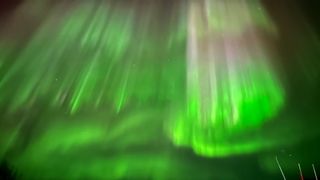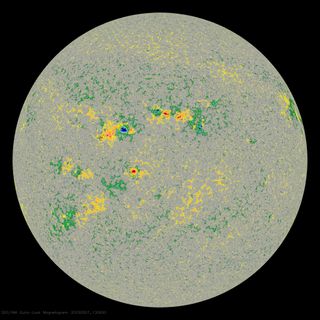Rare 'backward' sunspot could create supercharged auroras this week
It's believed that only 3% of all sunspots display reverse polarity as this one does.

An outburst from a law-breaking new sunspot could pummel Earth with charged particles and trigger strong geomagnetic storms, potentially causing spectacular light shows in skies over the planet during the coming days.
The geomagnetic storms will be the result of a massive coronal mass ejection (CME) hurled directly toward Earth by an explosion at a sunspot designated AR3296 that took place at 6:54 p.m. EDT (2254 GMT) on Sunday, May 7. Energetic particles from the outburst will arrive at Earth in the early hours of Wednesday (May 10). The same explosion that launched this CME also caused a medium-strength M1.5-class solar flare.
The violent solar activity from sunspot AR3296 is expected to impact Earth over Wednesday (May 10) and Thursday (May 11), and could cause auroras normally seen at high latitudes to extend much further south to mid-latitudes, possibly making them visible in U.S. states such as Oregon, Nebraska, and Virginia, SpaceWeather.com reported on May 9.
The sunspot that produced the storm is referred to as having reverse polarity, meaning it has the opposite magnetic field of other sunspots found on the same hemisphere of the sun. Only a tiny percentage of sunspots display this reverse polarity, making this sunspot incredibly rare in addition to more likely to explode as this one already has.
Related: Powerful sun storm could supercharge auroras this week
Solar flares are composed of energy, light and high-speed particles, meaning this aspect of the solar explosion struck Earth ahead of the plasma of the CME. The extreme ultraviolet radiation from the solar flare ionized the top of Earth's atmosphere, producing a radio blackout over the western U.S. and the Pacific Ocean.
According to SpaceWeather.com's Tony Phillips, sunspot AR3296 is considered a law-breaker because it runs contrary to a rule called Hale's Law. This law suggests that during the current 11-year solar cycle, Cycle 25, sunspots in the Northern Hemisphere should have polarities that are positively charged on the right and negatively charged on the left; AR3296 reverses this by being negatively charged on the right and positively charged on the left.
Get the Space.com Newsletter
Breaking space news, the latest updates on rocket launches, skywatching events and more!

Such reverse polarity sunspots are fairly uncommon; studies have found that only around 3% of these cool patches break Hale's Law. While they tend to be the same size as normal polarity sunspots and last for the same amount of time, reverse polarity sunspots are twice as likely to be the site of complex magnetic fields in which positive and negative poles are mixed.
This makes reverse polarity sunspots more likely to explode and create CME outbursts and solar flares just like AR3296 is currently doing. This rule-breaking sunspot is set to travel around the limb of the sun and away from Earth by the weekend, ending its bombardment of our planet.
The rogue sunspot flared again during the morning of Tuesday, May 9, with this being its fourth M-class, or medium-sized, flare in around just 36 hours. The intensity of these AR3296 flares is increasing and SpaceWeather reports that an X-class flare is possible from AR3296 before the weekend.
X-class flares are the strongest solar flare with ten times the energy of an M-class flare, which themselves are ten times as strong as C-class flares.
According to EarthSky.org, the forecast for flares from AR3296 between Tuesday and Wednesday is a 99% chance for C-class flares, a 55% chance for M-class flares, and a 20% chance for X-class flares.
Editor's Note: If you snap an image of auroras this week and would like to share it with Space.com's readers, send your photo(s), comments, and your name and location to spacephotos@space.com.
Join our Space Forums to keep talking space on the latest missions, night sky and more! And if you have a news tip, correction or comment, let us know at: community@space.com.

Robert Lea is a science journalist in the U.K. whose articles have been published in Physics World, New Scientist, Astronomy Magazine, All About Space, Newsweek and ZME Science. He also writes about science communication for Elsevier and the European Journal of Physics. Rob holds a bachelor of science degree in physics and astronomy from the U.K.’s Open University. Follow him on Twitter @sciencef1rst.
